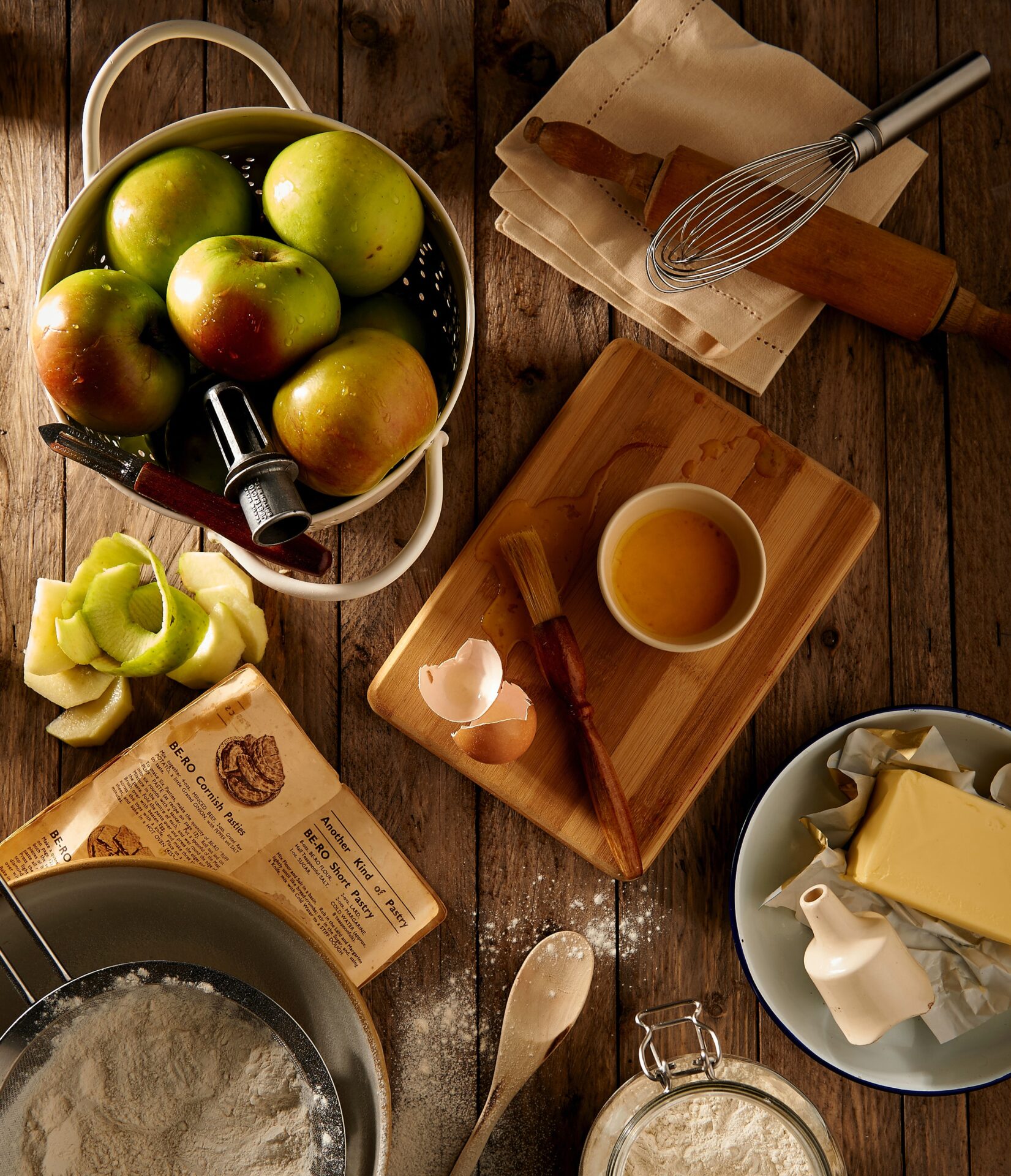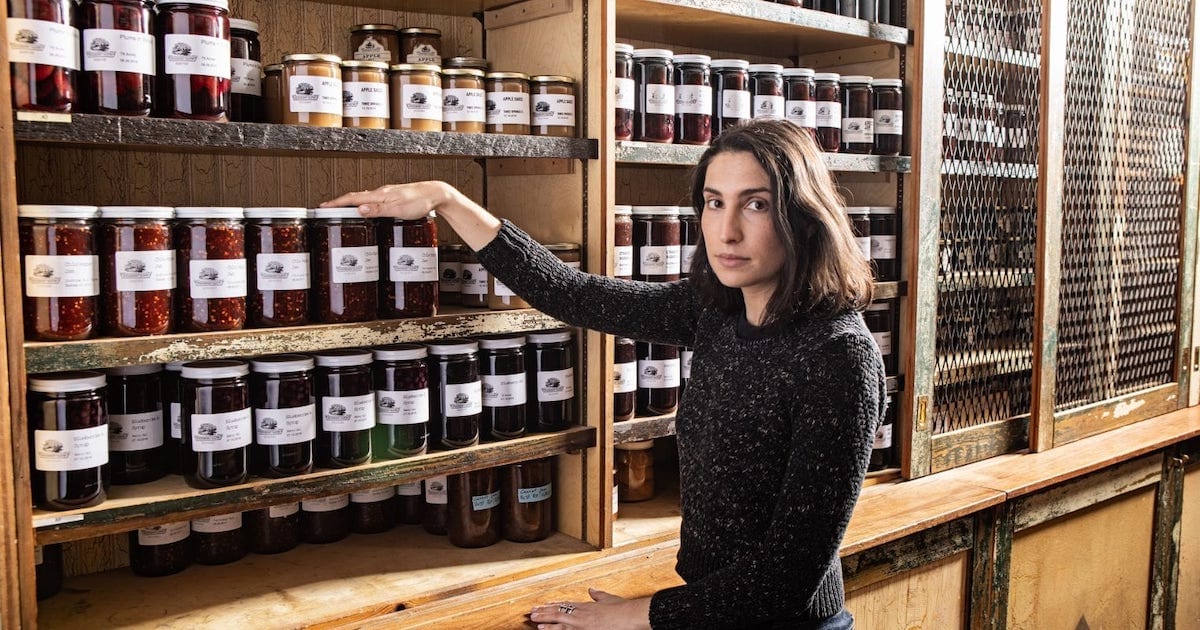Chesapeake Pantry
You’d need the imagination of Andy Warhol to see the sex appeal of canned food—to say nothing of the facility where it was processed and stored.
Down the steel stairs of a collaborative warehouse next to railroad tracks in Baltimore, cardboard boxes filled with jars of fruit jam and bottles of hot sauce sit alongside shelves piled with vacuum-sealed bags of dried peppers and prunes. This austere space is the physical manifestation of the preservation juggernaut known as Canningshed, the utilitarian side project of Spike Gjerde—Baltimore’s only James Beard winner.
What the operation lacks in glamour it more than makes up for in flavor and vision. Because it seems even Gjerde’s jars of jam come packed with a point of view—and there’s certainly no denying the seductive allure of his potent, piquant Snake Oil hot sauce, dispensed from an apothecary jar.
For the last several years, Gjerde and his wife, Amy, have built a restaurant empire on a simple premise: to serve local food without exception or compromise. Citrus doesn’t grow in the Mid-Atlantic, so it doesn’t appear in their kitchens. Since 2007, when they opened the celebrated Woodberry Kitchen, they have made headlines and earned wide acclaim with a handful of locavore coffee shops and restaurants in Baltimore and Washington, DC, from an elegant raw bar to a slushie-fueled beach bar. Gjerde’s team soon discovered that a strict adherence to local ingredients required some back-bending acrobatics in the off season. Like old times, they turned to preservation as a way to survive the lean winter months—and keep customers from seasonally afflicted root-vegetable burnout.
Five years ago, Lauren Sandler joined the team as the director of preservation. A former line cook with a fine arts background, the thirty-something Maryland native quickly proved herself a force to be reckoned with as she perfected ancient techniques and memorized health codes. Her experiences in Italian kitchens, including at Brooklyn’s cult-favorite Franny’s, introduced her to the art of food preservation. She describes the painstaking steps of making mushroom antipasto, for instance, with a giddy reverence. That authentic attention to detail positions her with one foot in Old-World kitchen techniques and the other in byzantine municipal regulations.
“It’s about figuring out processes, and understanding the way things react. Cooking is so scientific,” she says, though is quick to add that she tries not to “take away all the beautiful, romantic elements” as she navigates the complexity of pH levels and food permits.
Sandler and a nimble team of three aproned employees process between 60,000 and 80,000 pounds of locally grown produce a year, which become high-pressure pasteurized watermelon and cucumber juice, hot sauce and pepper mash, canned tomatoes and rhubarb jam. “We try and crank out as much as we can,” she says. Some of the resulting products are passed on to their own kitchens or sold to other local chefs, while others get branded as Woodberry Pantry and are sold online (at woodberrypantry.com) and on the shelves of regional grocery stores, as well as at Gjerde’s Artifact Coffee.

At its core, she says, Canningshed serves as an extension of the Woodberry mission. “We preserve food at its peak and abundance from growers that we’ve been working with for a long time.” That means sourcing rhubarb and berries from the bounty of local farmers markets, apples from seventh-generation Three Springs Fruit Farm in Pennsylvania, and green cherry tomatoes and heritage fish peppers from One Straw Farm in Baltimore County.
The last of those is a particular point of pride for Canningshed. Fish peppers—an elusive cousin of the Tabasco pepper—first arrived in the Chesapeake Bay region with African slaves, who used the light-colored pepper to add secret heat to fish stew and creamy white sauces. In the early twentieth century, the unusual ingredient fell out of favor and was all but forgotten until food historian William Woys Weaver rediscovered the spicy pepper and began encouraging local farmers to cultivate the heirloom seeds. To date, Canningshed has ground up more than 30,000 pounds of the peppers (at a profit of nearly $80,000 for local family growers), aged the mash in oak barrels, and transformed them into Gjerde’s signature Snake Oil hot sauce.
But Canningshed is doing more than simply reviving the local market for a heritage pepper. The company is offering a twenty-first century take on the Chesapeake Bay’s once-thriving canning industry—which began with oyster canning in the first half of the nineteenth century and reached its zenith in the 1920s, when hundreds of packing houses operated across Maryland. Like the bright flavors preserved inside a can, it’s an idea with staying power.

A Can-Do Approach to Mixing Drinks
Most cooks worth their salt can transform a can of quality tomatoes into a satisfying dinner. Savvy mixologists, likewise, elevate drinks by turning to pantry staples. A partner and director of operations for Spike Gjerde’s Foodshed restaurant group, Corey Polyoka also heads up the beverage programs and relies heavily on preserved ingredients to keep their drinks menus fresh year-round—from preserved sorghum to the leftover juice in a jar of peaches. “We have a fresh season and a preserve season,” he says. Here, he offers a few tips for giving your home bar a longer shelf life—and a lot more personality.
LET’S JAM: “Reconstitute or loosen up a jam to use in place of any sweetener in a cocktail,” says Polyoka. His gin-based cocktail the Pine Barrens, for instance, comes topped with cranberry-rosemary jam. Try a scoop of your favorite jam in a whiskey sour, he suggests, but remember that “a little bit goes a long way.”
UMAMI FOR YOU: Snake Oil makes an excellent secret ingredient for top-notch bloody marys. Polyoka’s method of choice: Season your mix with everything but the hot sauce—get the herbs and salt and pepper levels where you like them—and then finish things off with an umami pop by shaking in some Snake Oil.
ACIDITY, WITH A TWIST: For a well-balanced cocktail, think beyond the lemon peel—or lime wedge or flaming orange peel, for that matter. At Gjerde’s citrus-eschewing restaurants and bars, locally made vinegar and verjus (the juice from pressed, unripened grapes) plays a starring role alongside seasonal juices.

Canningshed’s Smoked Apple Brandy Margarita
share
trending content
-
Besting Barbecue Chicken with Elliot Moss
by Emily Havener -
River City Reawakening | Listen
by Erin Byers Murray -
The Ultimate Alabama Dining Guide | Listen
by Jennifer Stewart Kornegay -
6 Must-Visit Music Joints Across Mississippi
by TLP's Partners -
Taming the Flame | Listen
More From Roots
-
Infusion of Spirit with Alba Huerta | Listen
-
Meet a Local: Tank Jackson | Listen
-
Of Rice and Flavor with Nicole Cabrera Mills | Listen
-
ChòpnBlọk: A Journey to Connection
-
Bearing Fruit at Big Apple Inn









